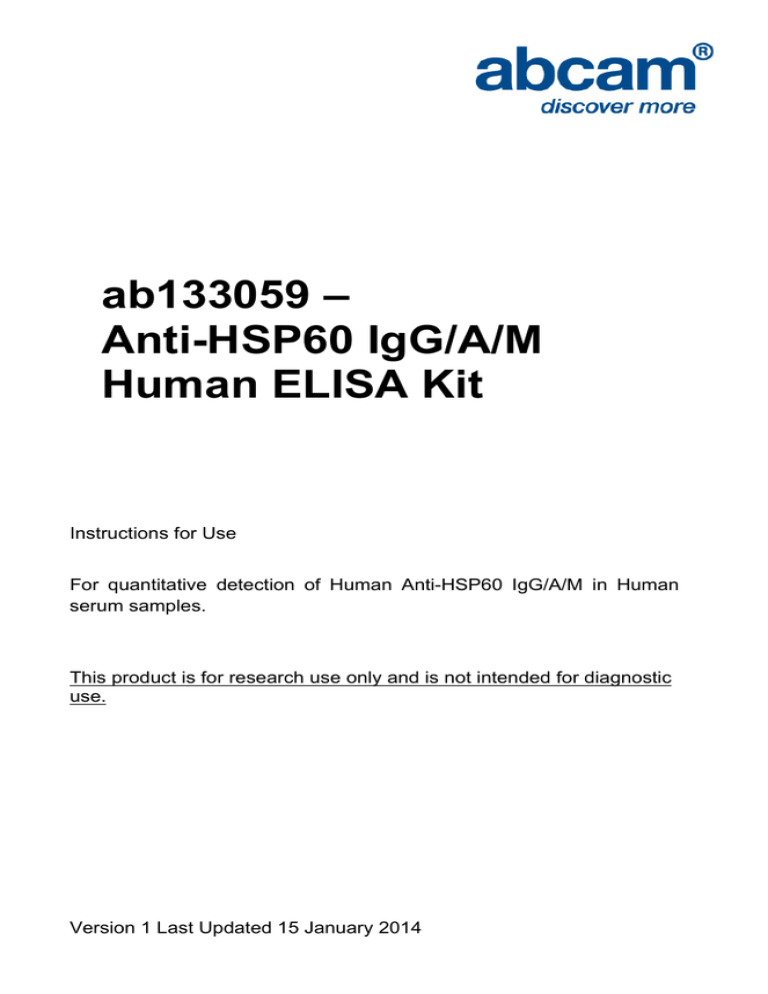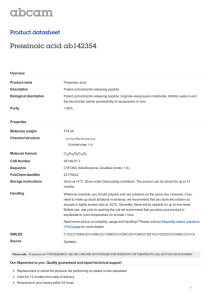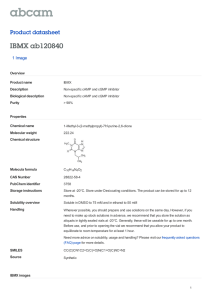
ab133059 –
Anti-HSP60 IgG/A/M
Human ELISA Kit
Instructions for Use
For quantitative detection of Human Anti-HSP60 IgG/A/M in Human
serum samples.
This product is for research use only and is not intended for diagnostic
use.
Version 1 Last Updated 15 January 2014
Table of Contents
INTRODUCTION
1.
BACKGROUND
2.
ASSAY SUMMARY
2
3
GENERAL INFORMATION
3.
PRECAUTIONS
4.
STORAGE AND STABILITY
5.
MATERIALS SUPPLIED
6.
MATERIALS REQUIRED, NOT SUPPLIED
7.
LIMITATIONS
8.
TECHNICAL HINTS
4
5
5
6
6
7
ASSAY PREPARATION
9.
REAGENT PREPARATION
10. STANDARD PREPARATIONS
11. SAMPLE COLLECTION AND STORAGE
12. PLATE PREPARATION
8
9
11
12
ASSAY PROCEDURE
13. ASSAY PROCEDURE
13
DATA ANALYSIS
14. CALCULATIONS
15. TYPICAL DATA
16. TYPICAL SAMPLE VALUES
17. ASSAY SPECIFICITY
14
15
16
17
RESOURCES
18.
19.
TROUBLESHOOTING
NOTES
Discover more at www.abcam.com
18
19
1
INTRODUCTION
1. BACKGROUND
Abcam’s Human Anti-HSP60 IgG/A/M in vitro ELISA (Enzyme-Linked
Immunosorbent Assay) kit is designed for the accurate quantitative
measurement of Human Anti-HSP60 in Human Serum. This assay
allows determination of IgG, IgA and IgM antibodies (total) to Human
Hsp60 in serum.
A recombinant Human Hsp60 protein has been precoated onto 96-well
plates. Standards or test samples are added to the wells, incubated
and then washed. An anti-Human GAM-HRP conjugated antibody is
then added and incubated. The plate is washed once more and the
TMB substrate is then added which HRP catalyzes, generating a blue
coloration after incubation. A stop solution is added which generates
conversion to yellow color read at 450 nm which is proportional to the
amount of analyte bound.
Traditional methods for detection and quantitation of antihuman Hsp60
antibodies were accomplished by using prescreened serum samples
with a high level of anti-Human Hsp60. These samples were assigned
a concentration of 1000 arbitrary units/mL (Aunits/mL) and were used
to generate standard dose-response curves from which antibody levels
in test samples were determined.
Assay Designs Anti-Human Hsp60 (total) ELISA kit uses a calibrated
standard of anti-Human Hsp60 (lgG/A/M) isolated from pooled Human
sera to generate a standard curve. The kit provides researchers with a
rapid, reliable and standardized method to measure the levels of antiHuman Hsp60 in Human serum samples by interpolating absorbance
readings from the standard curve.
Discover more at www.abcam.com
2
INTRODUCTION
2. ASSAY SUMMARY
Prepare all reagents, samples and
standards as instructed.
Add samples and standards to wells.
Add prepared labeled HRP-Conjugate.
Incubate at room temperature.
After washing, add TMB substrate
solution to each well. Incubate at room
temperature. Add Stop Solution to each
well. Read immediately.
Discover more at www.abcam.com
3
GENERAL INFORMATION
3. PRECAUTIONS
Please read these instructions carefully prior to beginning the
assay.
Stop Solution 2 is a 1 normal (1N) hydrochloric acid solution. This
solution is caustic; care should be taken in use
The activity of the anti-Human GAM-HRP Conjugate is affected by
nucleophiles such as azide, cyanide and hydroxylamine
We test this kit’s performance with a variety of samples, however it
is possible that high levels of interfering substances may cause
variation in assay results
The anti-HSP60 standard is derived from Human serum. Treat
as a biohazard
Discover more at www.abcam.com
4
GENERAL INFORMATION
4. STORAGE AND STABILITY
Store all components at 4°C immediately upon receipt, apart from
the Standard, which should be stored at -20°C. Avoid multiple
freeze-thaw cycles.
5. MATERIALS SUPPLIED
Amount
Storage
Condition
96 Wells
4ºC
Anti-Human GAM-HRP Conjugate
10 mL
4ºC
Human Anti-HSP60 Standard
120 µL
-20ºC
20X Wash Buffer Concentrate
100 mL
4ºC
TMB Substrate
10 mL
4ºC
Stop Solution 2
10 mL
4ºC
Sample Diluent 1
100 mL
4ºC
Item
Human Anti-HSP60 IgG/A/M Microplate
(12 x 8 wells)
Discover more at www.abcam.com
5
GENERAL INFORMATION
6. MATERIALS REQUIRED, NOT SUPPLIED
These materials are not included in the kit, but will be required to
successfully utilize this assay:
Standard microplate reader - capable of reading at 450 nm,
preferably with correction between 570 and 590 nm
Automated plate washer (optional)
Adjustable pipettes and pipette tips. Multichannel pipettes are
recommended when large sample sets are being analyzed
Eppendorf tubes
Microplate Shaker
Absorbent paper for blotting
Deionized water
7. LIMITATIONS
Assay kit intended for research use only. Not for use in diagnostic
procedures
Do not mix or substitute reagents or materials from other kit lots or
vendors. Kits are QC tested as a set of components and
performance cannot be guaranteed if utilized separately or
substituted
Discover more at www.abcam.com
6
GENERAL INFORMATION
8. TECHNICAL HINTS
Standards can be made up in either glass or plastic tubes
Pre-rinse the pipette tip with the reagent, use fresh pipette tips for
each sample, standard and reagent
Pipette standards and samples to the bottom of the wells
Add the reagents to the side of the well to avoid contamination
This kit uses break-apart microtiter strips, which allow the user to
measure as many samples as desired. Unused wells must be kept
desiccated at 4°C in the sealed bag provided. The wells should be
used in the frame provided
Prior to addition of substrate, ensure that there is no residual wash
buffer in the wells. Any remaining wash buffer may cause variation
in assay results
It is important that the matrix for the standards and samples be as
similar as possible. Human Anti-HSP60 IgG/A/M samples diluted
with Sample Diluent 1 should be run with a standard curve diluted
in the same buffer. Serum samples should be evaluated against a
standard curve run in Sample Diluent 1 while culture supernatant
samples should be read against a standard curve diluted in the
same complete but non‐conditioned media
This kit is sold based on number of tests. A ‘test’ simply
refers to a single assay well. The number of wells that contain
sample, control or standard will vary by product. Review the
protocol completely to confirm this kit meets your
requirements. Please contact our Technical Support staff with
any questions
Discover more at www.abcam.com
7
ASSAY PREPARATION
9. REAGENT PREPARATION
Equilibrate all reagents and samples to room temperature (18 - 25°C)
prior to use.
9.1
1X Wash Buffer
Prepare the 20X Wash Buffer by equilibrating to room
temperature and swirl gently to dissolve any crystals that
may have formed from storage Dilute 100 mL of the
20X Wash Buffer Concentrate in 1,900 mL of deionized
water. Mix thoroughly and gently.
Discover more at www.abcam.com
8
ASSAY PREPARATION
10. STANDARD PREPARATIONS
Prepare serially diluted standards immediately prior to use. Always
prepare a fresh set of standards for every use. Dilutions of the AntiHSP60 IgG/A/M standard should be used within 60 minutes of
preparation. The anti-HSP60 standard is derived from Human
serum. Treat as a biohazard.
10.1 Allow the anti-HSP60 standard to equilibrate to room
temperature. Centrifuge the anti-HSP60 standard before
removing cap.
10.2 Label seven tubes with numbers 1 – 7.
10.3 Add 500 μL appropriate diluent into tubes numbers 2 – 7.
10.4 Prepare a 250 ng/mL Standard 1 by transferring 100 µL of
the 2,500 ng/mL Stock Standard to 900 μL of the appropriate
diluent to tube 1. Mix thoroughly and gently.
10.5 Prepare Standard 2 by transferring 500 μL from Standard 1
to tube 2. Mix thoroughly and gently.
10.6 Prepare Standard 3 by transferring 500 μL from Standard 2
to tube 3. Mix thoroughly and gently.
10.7 Using the table below as a guide, repeat for tubes 4 through
6.
10.8 Standard 7 contains no protein and is the blank control.
Discover more at www.abcam.com
9
ASSAY PREPARATION
Standard
Sample to
Dilute
Volume
to Dilute
(µL)
1
2
3
4
5
6
7
Stock
Standard 1
Standard 2
Standard 3
Standard 4
Standard 5
None
100
500
500
500
500
500
-
Discover more at www.abcam.com
Volume
of
Diluent
(µL)
900
500
500
500
500
500
500
Starting
Conc.
(ng/mL)
Final
Conc.
(ng/mL)
2,500
250
125
62.5
31.25
15.63
-
250
125
62.5
31.25
15.63
7.81
0
10
ASSAY PREPARATION
11. SAMPLE COLLECTION AND STORAGE
The Anti-HSP60 IgG/A/M Human ELISA kit is compatible with AntiHSP60 IgG/A/M samples in a wide range of matrices after dilution
in Assay Buffer. However, the end user must verify that the
recommended dilutions are appropriate for their samples. Samples
containing Human IgG may interfere with the assay.
SAMPLE PREPARATIONS
11.1 Collection of serum
11.1.1 Collect whole blood using a serum separator tube.
11.1.2 Allow samples to clot at room temperature for 30
minutes.
11.1.3 Centrifuge at approximately 1,000 x g for 10 minutes,
taking precautions to avoid hemolysis.
11.1.4 Remove serum. Transfer the serum to a labeled
polypropylene tube. The serum collected is now ready
for analysis using the Anti-Human Hsp60 (total) ELISA
Kit.
11.1.5 Alternatively, the serum sample can be frozen at
≤-20°C and assayed at a later date. It is recommended
that the serum be aliquoted to convenient volumes
prior to storing at ≤-20°C to avoid multiple freeze thaw
cycles.
11.2 Dilution of samples
11.2.1 Serum can be diluted 1:1000 (v/v) in Sample Diluent 1
by a 2 step serial dilution (1:10 dilution followed by a
1:100 dilution). This is a suggested starting dilution
only. Additional dilutions may be necessary to ensure
that sample values are within the range of the
standard curve. Users must determine the optimal
sample dilutions for their particular experiments.
Discover more at www.abcam.com
11
ASSAY PREPARATION
11.2.2 Dilute prepared samples in Sample Diluent 1. Prepare
at least 250 μL of diluted sample to permit assaying in
duplicate.
11.2.3 Mix thoroughly.
11.2.4 Samples are now ready to be used in the Assay
Procedure. Samples may be left at room temperature
while reagents are being prepared.
12. PLATE PREPARATION
The 96 well plate strips included with this kit are supplied ready to
use. It is not necessary to rinse the plate prior to adding reagents
Unused well strips should be returned to the plate packet and
stored at 4°C
For each assay performed, a minimum of 2 wells must be used as
blanks, omitting primary antibody from well additions
For statistical reasons, we recommend each sample should be
assayed with a minimum of two replicates (duplicates)
Well effects have not been observed with this assay. Contents of
each well can be recorded on the template sheet included in the
Resources section
Discover more at www.abcam.com
12
ASSAY PROCEDURE
13. ASSAY PROCEDURE
Equilibrate all materials and prepared reagents to room
temperature prior to use
It is recommended to assay all standards, controls and
samples in duplicate
13.1
Prepare all reagents, working standards, and samples as
directed in the previous sections.
13.2
Add 100 μL of Standards 1 through 7 into the appropriate
wells.
13.1
Add 100 μL of samples into the appropriate wells.
13.2
Empty the contents of the wells and wash by adding 400 µL
of 1X Wash Buffer to every well. Repeat the wash 3 more
times for a total of 4 washes. After the final wash, empty or
aspirate the wells, and firmly tap the plate on a lint free
paper towel to remove any remaining wash buffer.
13.3
Add 100 μL of Anti-Human GAM-HRP Conjugate to every
well.
13.4
Cover wells with a fresh adhesive plate sealer or plastic
wrap and incubate at room temperature for 1 hour,
preferably with gentle mixing.
13.5
Add 100 μL of the TMB Substrate solution to every well.
Incubate at room temperature for 15 minutes on a plate
shaker.
13.6
Add 100 μL Stop Solution 2 into each well in the same
order that the TMB Substrate was added. The plate should
be read immediately.
13.7
Read the O.D. absorbance at 450 nm, preferably with
correction between 570 and 590 nm.
Discover more at www.abcam.com
13
DATA ANALYSIS
14. CALCULATIONS
A four parameter algorithm (4PL) provides the best fit, though other
equations can be examined to see which provides the most accurate
(e.g. linear, semi-log, log/log, 4 parameter logistic). Interpolate protein
concentrations for unknown samples from the standard curve plotted.
Samples producing signals greater than that of the highest standard
should be further diluted and reanalyzed, then multiplying the
concentration found by the appropriate dilution factor.
Discover more at www.abcam.com
14
DATA ANALYSIS
15. TYPICAL DATA
TYPICAL STANDARD CURVE – Data provided for demonstration
purposes only. A new standard curve must be generated for each
assay performed.
Sample
Conc.
(ng/mL)
Mean O.D.
(-Blank)
Standard 1
250
0.873
Standard 2
125
0.405
Standard 3
62.5
0.176
Standard 4
31.25
0.086
Standard 5
15.63
0.045
Standard 6
7.81
0.029
Discover more at www.abcam.com
15
DATA ANALYSIS
16. TYPICAL SAMPLE VALUES
SENSITIVITY –
The sensitivity, minimum detectable dose of Anti-HSP60 IgG/A/M
using this Abcam ELISA kit was found to be 2.88 ng/mL. This was
determined by the average optical density of the 0 pg/mL Standard and
comparing to the average optical density for Standard 6. The detection
limit was determined as the concentration of Anti-HSP60 IgG/A/M
measured at two standard deviations from the zero along the standard
curve.
LINEARITY OF DILUTION –
A sample containing 189.3 ng/mL Anti-HSP60 IgG/A/M was diluted 5
times 1:2 in the kit Sample Diluent 1 and measured in the assay. The
data was plotted graphically as actual Anti-HSP60 IgG/A/M
concentration versus measured Anti-HSP60 IgG/A/M concentration.
The line obtained had a slope of 0.948 and a correlation coefficient of
0.998.
PRECISION –
Intra-Assay Precision
To determine Intra-Assay Precision, samples containing low, medium
and high concentrations of anti-Human Hsp60 were assayed sixteen
times on one plate. The Intra-Assay coefficient of variation of the AntiHuman Hsp60 (total) ELISA was determined to be <10%.
b) Inter-Assay Precision
To determine Inter-Assay Precision, three samples containing low,
medium and high concentrations of anti-Human Hsp60 were assayed
in eight individual assays. The Inter-Assay coefficient of variation of the
Anti-Human Hsp60 (total) ELISA was determined to be <10%.
Discover more at www.abcam.com
16
DATA ANALYSIS
17. ASSAY SPECIFICITY
CROSS REACTIVITY –
The Anti-HSP60 IgG/A/M ELISA Kit recognizes
recombinant forms of Anti-HSP60 IgG/A/M.
natural
and
There was no Cross reactivities with the Anti-HSP60 IgG/A/M ELISA
kit.
Discover more at www.abcam.com
17
RESOURCES
18. TROUBLESHOOTING
Problem
Poor
standard
curve
Low Signal
Samples
give higher
value than
the highest
standard
Cause
Solution
Inaccurate pipetting
Check pipettes
Improper standards
dilution
Prior to opening, briefly spin the
stock standard tube and dissolve
the powder thoroughly by gentle
mixing
Incubation times too
brief
Ensure sufficient incubation times;
change to overnight
standard/sample incubation
Inadequate reagent
volumes or improper
dilution
Check pipettes and ensure correct
preparation
Starting sample
concentration is too
high.
Dilute the specimens and repeat
the assay
Plate is insufficiently
washed
Review manual for proper wash
technique. If using a plate washer,
check all ports for obstructions
Contaminated wash
buffer
Prepare fresh wash buffer
Improper storage of
the kit
Store the all components as
directed
Large CV
Low
sensitivity
Discover more at www.abcam.com
18
RESOURCES
19. NOTES
Discover more at www.abcam.com
19
RESOURCES
Discover more at www.abcam.com
20
RESOURCES
Discover more at www.abcam.com
21
RESOURCES
Discover more at www.abcam.com
22
UK, EU and ROW
Email: technical@abcam.com | Tel: +44-(0)1223-696000
Austria
Email: wissenschaftlicherdienst@abcam.com | Tel: 019-288-259
France
Email: supportscientifique@abcam.com | Tel: 01-46-94-62-96
Germany
Email: wissenschaftlicherdienst@abcam.com | Tel: 030-896-779-154
Spain
Email: soportecientifico@abcam.com | Tel: 911-146-554
Switzerland
Email: technical@abcam.com
Tel (Deutsch): 0435-016-424 | Tel (Français): 0615-000-530
US and Latin America
Email: us.technical@abcam.com | Tel: 888-77-ABCAM (22226)
Canada
Email: ca.technical@abcam.com | Tel: 877-749-8807
China and Asia Pacific
Email: hk.technical@abcam.com | Tel: 108008523689 (中國聯通)
Japan
Email: technical@abcam.co.jp | Tel: +81-(0)3-6231-0940
www.abcam.com | www.abcam.cn | www.abcam.co.jp
Copyright © 2013 Abcam, All Rights Reserved. The Abcam logo is a registered trademark.
All information / detail is correct at time of going to print.
RESOURCES
23




